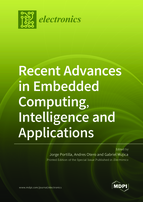Recent Advances in Embedded Computing, Intelligence and Applications
A special issue of Electronics (ISSN 2079-9292). This special issue belongs to the section "Computer Science & Engineering".
Deadline for manuscript submissions: closed (31 December 2020) | Viewed by 36423
Special Issue Editors
Interests: embedded-system design; wireless-sensor networks; Internet of Things and FPGA-based reconfigurable systems
Special Issues, Collections and Topics in MDPI journals
Interests: embedded-system design; 3D vision; FPGA-based reconfigurable systems; machine learning in the edge
Special Issues, Collections and Topics in MDPI journals
Special Issue Information
Dear Colleagues,
The latest proliferation of Internet of Things deployments and edge computing combined with artificial intelligence has led to new exciting application scenarios, where embedded digital devices are key enablers of such ecosystems. Moreover, new powerful and efficient devices are appearing to cope with workloads formerly reserved for the cloud, such as deep learning, processing close to where data is being generated, and avoiding bottlenecks due to communications limitations.
In this Special Issue, we look forward to present new works on offloading processing tasks from the cloud to the edge with the new devices available in the market nowadays, including neural accelerators, FPGAs, and embedded processors with AI enhancements. Application papers showing implementations and deployments in this context are very welcome as well.
Prof. Dr. Jorge Portilla
Prof. Dr. Andres Otero
Prof. Dr. Gabriel Mujica
Guest Editors
Manuscript Submission Information
Manuscripts should be submitted online at www.mdpi.com by registering and logging in to this website. Once you are registered, click here to go to the submission form. Manuscripts can be submitted until the deadline. All submissions that pass pre-check are peer-reviewed. Accepted papers will be published continuously in the journal (as soon as accepted) and will be listed together on the special issue website. Research articles, review articles as well as short communications are invited. For planned papers, a title and short abstract (about 100 words) can be sent to the Editorial Office for announcement on this website.
Submitted manuscripts should not have been published previously, nor be under consideration for publication elsewhere (except conference proceedings papers). All manuscripts are thoroughly refereed through a single-blind peer-review process. A guide for authors and other relevant information for submission of manuscripts is available on the Instructions for Authors page. Electronics is an international peer-reviewed open access semimonthly journal published by MDPI.
Please visit the Instructions for Authors page before submitting a manuscript. The Article Processing Charge (APC) for publication in this open access journal is 2400 CHF (Swiss Francs). Submitted papers should be well formatted and use good English. Authors may use MDPI's English editing service prior to publication or during author revisions.
Keywords
- Artificial intelligence in the edge
- Neural processors in edge platforms
- Artificial intelligence in IoT
- Deep learning in the edge
- Edge computing in embedded electronics
- Machine Learning in IoT devices
- Machine learning applications in the edge







